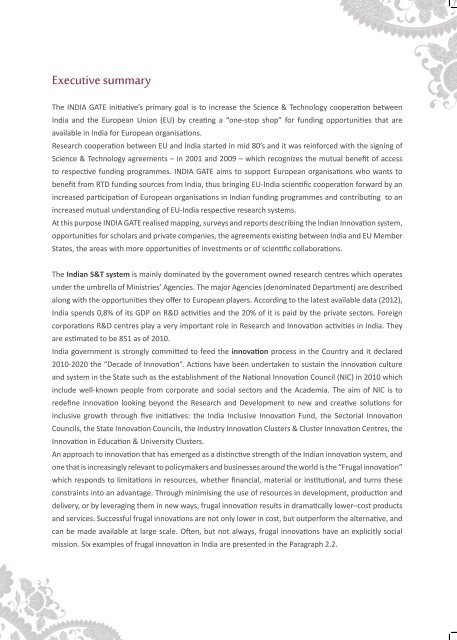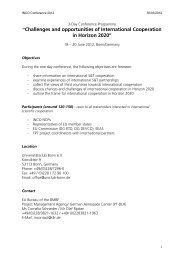Cooperate with India
Cooperate with India
Cooperate with India
- No tags were found...
Create successful ePaper yourself
Turn your PDF publications into a flip-book with our unique Google optimized e-Paper software.
Executive summaryThe INDIA GATE initiative’s primary goal is to increase the Science & Technology cooperation between<strong>India</strong> and the European Union (EU) by creating a “one-stop shop” for funding opportunities that areavailable in <strong>India</strong> for European organisations.Research cooperation between EU and <strong>India</strong> started in mid 80’s and it was reinforced <strong>with</strong> the signing ofScience & Technology agreements – in 2001 and 2009 – which recognizes the mutual benefit of accessto respective funding programmes. INDIA GATE aims to support European organisations who wants tobenefit from RTD funding sources from <strong>India</strong>, thus bringing EU-<strong>India</strong> scientific cooperation forward by anincreased participation of European organisations in <strong>India</strong>n funding programmes and contributing to anincreased mutual understanding of EU-<strong>India</strong> respective research systems.At this purpose INDIA GATE realised mapping, surveys and reports describing the <strong>India</strong>n Innovation system,opportunities for scholars and private companies, the agreements existing between <strong>India</strong> and EU MemberStates, the areas <strong>with</strong> more opportunities of investments or of scientific collaborations.The <strong>India</strong>n S&T system is mainly dominated by the government owned research centres which operatesunder the umbrella of Ministries’ Agencies. The major Agencies (denominated Department) are describedalong <strong>with</strong> the opportunities they offer to European players. According to the latest available data (2012),<strong>India</strong> spends 0,8% of its GDP on R&D activities and the 20% of it is paid by the private sectors. Foreigncorporations R&D centres play a very important role in Research and Innovation activities in <strong>India</strong>. Theyare estimated to be 851 as of 2010.<strong>India</strong> government is strongly committed to feed the innovation process in the Country and it declared2010-2020 the “Decade of Innovation”. Actions have been undertaken to sustain the innovation cultureand system in the State such as the establishment of the National Innovation Council (NIC) in 2010 whichinclude well-known people from corporate and social sectors and the Academia. The aim of NIC is toredefine innovation looking beyond the Research and Development to new and creative solutions forinclusive growth through five initiatives: the <strong>India</strong> Inclusive Innovation Fund, the Sectorial InnovationCouncils, the State Innovation Councils, the Industry Innovation Clusters & Cluster Innovation Centres, theInnovation in Education & University Clusters.An approach to innovation that has emerged as a distinctive strength of the <strong>India</strong>n innovation system, andone that is increasingly relevant to policymakers and businesses around the world is the “Frugal innovation”which responds to limitations in resources, whether financial, material or institutional, and turns theseconstraints into an advantage. Through minimising the use of resources in development, production anddelivery, or by leveraging them in new ways, frugal innovation results in dramatically lower–cost productsand services. Successful frugal innovations are not only lower in cost, but outperform the alternative, andcan be made available at large scale. Often, but not always, frugal innovations have an explicitly socialmission. Six examples of frugal innovation in <strong>India</strong> are presented in the Paragraph 2.2.














